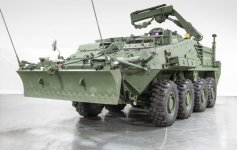The BTG is a good example of this problem, being something of a compromise to get decent value out mixed force of contract soldiers and conscripts.
The problem with a BTG is that it's like a battle group and dependent on the ability of elements to work on a combined arms concept. That takes good mid level leadership and significant and complex training. From what I recall about the early stages of this conflict, many of the infantry units were well below strength with BTRs and BMPs not having much more than their basic crew and with few dismounts. On the artillery side the BTGs then had problems as they were back in the order of march and had trouble deploying into action in the terrain conditions at the time.
This gets to my speculation about problems with Russian firepower; I think they want to do more than just Bn attacks, but they can't manage to organize the necessary artillery support (or the maneuver forces, for that matter).
That's a problem for the Ukrainians, too. Considering they've both had two years to correct their shortfalls it makes me wonder about how easily Canada can scale back up to brigade and above operations.
I'm aware of how the ballistics works. It's not entirely luck; maybe mostly, but not entirely. If you know where the enemy is going to be canalized and have a recorded target sitting on it, there is a good chance you will get good results. I have seen some highly responsive shooting that opens and remains close to a target, and I have seen more than a few tanks or BMPs get disabled or destroyed by artillery.
In order to destroy a target, the projectile needs to either hit the target or land very, very close. Ordinarily, near misses can shred aerials and optics and tires but generally that leaves the vehicle capable of withdrawing. Disabling a vehicle has value in its own right. Soft skin and lightly armoured vehicles can, of course, have splinters penetrate and either kill or wound occupants and damage equipment and possibly detonate on-board explosives.
You can certainly plan DF targets (and should) and with laser rangefinders and GPS you can easily calculate a known target point. Assuming the round flies true, and you can control the fire of the gun and the known time of flight (which is the easy part) you still need to be able to gauge the movement of the vehicle, which if properly operated, doesn't just mindlessly proceed in a straight line at a steady rate.
Assuming that you can deal with all that, you still have the PE problem which is uncontrollable. It can only be compensated for by increasing the number of rounds fired simultaneously at that spot. Dealing with a multiple vehicle attack compounds the problem if they deploy with the required dispersion between vehicles.
Honestly, my rule of thumb is to keep things simple - you take out a moving target with a guided weapon - whether that's a drone, or an ATGM, or a laser guided round depends on what you have and what's most effective in the situation. That's not to say you can't use dumb rounds to disable or destroy a moving target. B-GL-371-002 Duties of the Battery Commander and the Observer at Chapter 3, Section 8 deals with the techniques involved in engagement of mobile targets and ammunitions such as DPICM scatterable mines, if available, can also be used in this circumstance. It's just that the expenditure of "dumb" rounds to accomplish any effect is very high. That creates a logistics burden.
I don't think the range is a big factor, but it is something that impacts overall accuracy. The probable errors do go up with range, but it also magnifies the effects of orientation errors or questionable MV data (the bad gun/bad ammo problem).
Range is a factor as to which targets you can engage. As a rule of thumb Canadian CS artillery deploy into artillery manoeuvre areas with the intent of having at least 2/3 of its range extending beyond the forward edge of its own troops. That's so as to be able to strike areas in depth such as reserves, enemy gun batteries, assembly areas, logistics centres and routes, headquarters, advancing reinforcements, etc.
Russian defensive doctrine talks about having the forward edge of the brigade artillery group start about 2-4 kms from the forward edge of the main defensive positions and extending as 3 to 5 kms wide and 1-2 kms deep. (It's the same for the offence generally but hard to accomplish) That's a very concentrated and forward area for some nine batteries but is designed to hit out at the enemies approach march. That presupposes that the enemy's artillery, in the approach, is well back.
The further back you move your guns, the less ability you have to hit these vital targets. The Russian 152mm 2S19 series of SPs generally reach out to 25 to 29 kms. At a standard 3-6 kms setback, that leaves some 20 kms of range forward. As artillery batteries step back to avoid counterfire they lose the ability to reach deep into the enemy's rear. There is a simple reality to the 2/3 range rule of thumb; if you have near parity with the enemy's guns' range then you will never be free of the reach of counterfire as the ranges will always overlap the gun positions. That makes deception, mobility and protection vital. And that's even before you throw in GS arty, drones everywhere and rocket systems.




